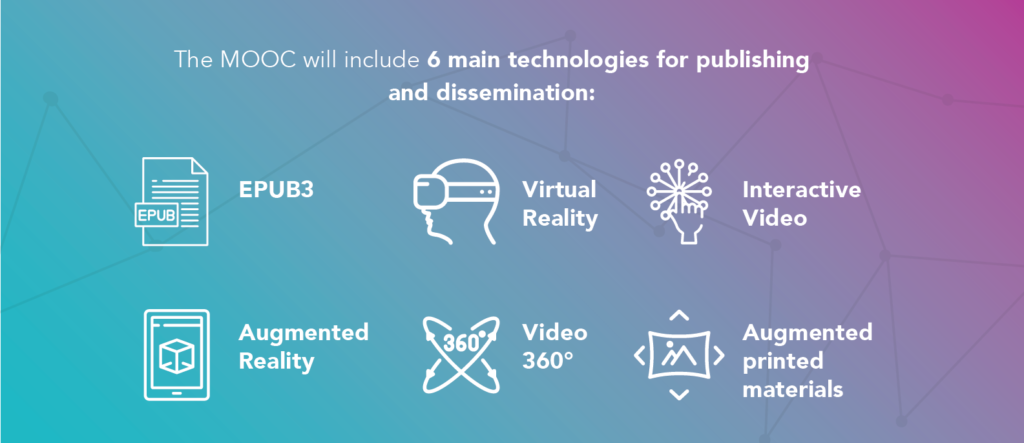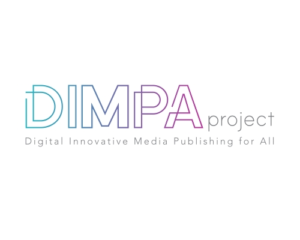How do you react when you read the following words: “EPUB 3”, “augmented reality”, “virtual reality”, “360 video”, “interactive video” and “augmented printed material”? Do you feel excited or confused? Maybe some words sounded interesting, and the others scared you. It is very likely that you have already seen or used such media. This article introduces the DIMPA project, in which our partners and ourselves will develop a MOOC on innovative digital publishing. At the end, just to make sure you know what we talk about, we will list a few examples of these technologies.
It probably seems that we are stating the obvious when we write that digital skills are as important as being able to read or write. Last year, European Commissioner Mariya Gabriel stated that “after 2020, around 90% of jobs will require basic digital skills and knowledge.” However, the European Union is facing a shortage of digital skills. According to a factsheet released in September 2017 by the European Commission (“A Digital Europe needs Digital Skills”), only 56% of Europeans aged from 16 to 75 have at least basic digital skills.
We probably all consume new forms of enriched media content online, such as 360 or interactive videos, augmented printed material, or augmented and virtual reality apps. Still, if we only use them and do not understand how to create them, we are not tech savvy. We are just users. Just because you know how to drive a car does not mean that you can build or repair one.
Children and teenagers might look like tech experts. But as long as they are only users and not creators, they are not equipped to properly understand the technologies they are using.
In addition, new technologies are often perceived as complex, expensive and reserved for specialists and often cause reluctance or even anxiety when companies try to implement them in their working habits. The lack of knowledge of easy-to-use creation tools increases the gap between tech specialists and enthusiasts and all the other professionals.
This is why we wish to equip new professionals with up to date skills in the main digital publishing media and tools. The partners of the DIMPA project intend to create the first European training on the practices and tools of 6 main technologies used in enhanced contents publishing and dissemination: EPUB 3, Augmented Reality, Virtual Reality, Video 360°, Interactive Video and augmented printed materials.
Practically, the Digital Innovative Media Publishing for All project will create:
- A MOOC on the new technologies of enhanced content publishing for learners in Vocational Education and Training (VET),
- Toolkits on the tools of production and a database of available resources,
- Reusable models for each technology,
- Explanatory sheets,
- A training implementation guide for VET trainers.

The consortium of the project gathers VET providers and digital specialists to develop a training that can tackle the European shortage in digital skills, beyond borders and across professional sectors. To make sure the impact of the DIMPA project is sustainable, we will also train teachers and trainers. We will design a MOOC that can be easily integrated into VET curricula with appropriate certification (worth 1 ECVET).
In addition, we will pay a special attention to make the content available for all in order to avoid leaving learners on the side. Therefore, the content that will be created will be designed to be adapted as much as possible for individuals with Specific Learning Disorders (SLD), who represent 8 to 15% of the population in Europe.
BONUS
As mentioned in the introduction, here are a few examples of the technologies we mention.
EPUB3
EPUB is a digital publishing standard published by the International Digital Publishing Forum (IDPF).
Learn more: http://idpf.org/epub/30
VIRTUAL REALITY
“Virtual reality, or VR, is an interactive computer-generated experience taking place within a simulated environment. It incorporates mainly auditory and visual feedback, but may also allow other types of sensory feedback.” (source: Wikipedia)
This video presents the technology in under 3 minutes.
INTERACTIVE VIDEO
An interactive video is a movie that requires user interaction (eg. clicking) for direction.
This article presents different stories told through interactive videos.
AUGMENTED REALITY
An enhanced version of reality created by the use of technology to overlay digital information on an image of something being viewed through a device (such as a smartphone camera). (source)
This video shows different examples of AR technology usage.
360 VIDEO
360 videos are created using a rig of cameras that are positioned to record all around them. Each feed of video is then stitched together using software to offer the ability to view “all around” you. (source)
See an example in this video.
AUGMENTED PRINTED MATERIAL
Augmented printed materials are prints that you can scan, using a smartphone for example, to get additional content related to the print you are reading. For example, it is possible to use augmented reality to show the 3D model of an object (for example a product) when someone interacts with the print.
Check here how The New Yorker magazine is using this technology.

![]() Follow us on Facebook: @dimpapro
Follow us on Facebook: @dimpapro
#DIMPAproject #VR #AR #erasmusplus
Visit the project website : www.dimpaproject.eu
In collaboration with: The Berufsförderungsinstitut Oberösterreich (BFI-OÖ), Les Apprimeurs, AKETH [Developmental Centre Of Thessaly – D.C.T.], CEPS Projectes Socials, MBCF

